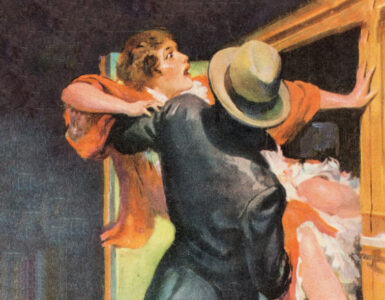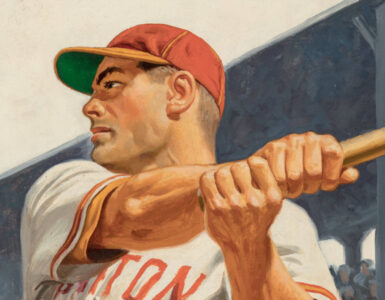 Pulp magazines have influenced writers, artists, film directors, software developers, and countless others over the years. Our “PulpFest Profiles” focus on contemporary creators who have drawn inspiration from these rough-paper fiction magazines.
Pulp magazines have influenced writers, artists, film directors, software developers, and countless others over the years. Our “PulpFest Profiles” focus on contemporary creators who have drawn inspiration from these rough-paper fiction magazines.
In this month’s “PulpFest Profile” we’ll chat with author, educator, and editor Heidi Ruby Miller. Heidi travels the globe with her husband and writing partner, Jason Jack Miller, while researching their books and articles. She has an extremely diverse background including degrees in Geography, Travel & Tourism, and Anthropology. Between trips to exotic locations, she teaches creative writing at Pennsylvania’s Seton Hill University and is an editor at Dog Star Books, an imprint of Raw Dog Screaming Press. From romantic suspense novels to space thrillers, from teaching to travel writing, Heidi Ruby Miller is a woman of many talents. I’m excited to share some of her adventures with you today!
Sara Light-Waller (SLW) Hello Heidi, thank you for joining us! Let’s start with your background. When did you first know you wanted to be a writer?
Heidi Ruby Miller (HRM) I wrote my first story — The Copper Kitty Mystery — in second grade and listed “romance novelist” as one of my high school ambitions. But I didn’t become serious about it until my late twenties, right before I found Seton Hill’s graduate program in Writing Popular Fiction. I haven’t stopped writing since.
(SLW) You have an extremely wide-ranging background. How does this influence your plot ideas?
(HRM) I am constantly plotting, just ask my husband, Jason. Now, we plot together, usually while hiking. In fact, we’ve called on ideas from our backgrounds in science, travel, and culture for two new speculative series that our agent is currently shopping.
Having worked on archaeological sites, both as a student and a professional, there’s always some element of adventurous discovery in everything I write. It can be literal — digging to find a clue — or just a metaphor for the truth, but the feeling remains the same for me. Having undergraduate degrees in Geography with a specialty in Travel and Tourism, and in Anthropology with a specialty in Archaeology, it was inevitable that I’d become a travel writer. That’s when Jason and I first collaborated.
When I moved into fiction, I wrote a romantic suspense novel and a thriller, both of which relied heavily upon archaeology at their centers. Neither was published, but I brought my university studies into my Ambasadora series, as well. I have often called that series Anthropological Science Fiction because I spent six years creating very distinctive cultures for this expansive world: class and breeding circles, death ceremonies, and a new religion — worshipping ‘the History.’ I also played up the idea 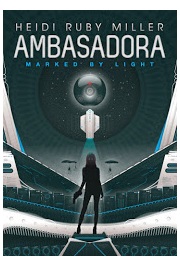 of love being an emotional fallacy and the hypocrisy of a society that will not use the word but shows they feel it in everything they do.
of love being an emotional fallacy and the hypocrisy of a society that will not use the word but shows they feel it in everything they do.
(SLW) You’ve said you equate space opera with westerns. Can you tell us more about this?
(HRM) The connection between westerns and space opera has been around for decades, although it took Joss Whedon’s series Firefly to make the connection very overt. Even the original Star Trek used the motto: “Space, the final frontier.” One often finds the unexplored territory, the adventurer archetype, and an emphasis on settlements within space opera. That makes it easy to pluck the story out of an extraterrestrial setting and plop it down in the Old West. That is precisely why space opera can have limited fandom in purer science fiction circles. After all, one of the tenets of science fiction is that if the science (tech, advancements, etc.) is stripped away, the story should fall apart. Whether or not this assessment is accurate depends on individual works labeled as space opera. I’d like to think my space opera is absolutely tied to science, but perhaps not as much as Asimov’s work, for instance.
(SLW) How did the old pulps inspire your own writing? Did any of them especially influence your Ambasadora series? If so, which ones?
(HRM) As an academic, I find that, in some circles, all genre fiction is considered pulp, regardless of its content, when it was written, or who did the writing. Basically, if it’s not literary, then to much of academia, it’s utterly disposable. I’m lucky to be surrounded by a special group of academics who know otherwise. Some of my influences for the Ambasadora books came from reading Philip K. Dick, Arthur C. Clarke, and Isaac Asimov, among others. I leave it to your readers to decide who among those authors were pulpsters.
(SLW) What inspired you to teach writing? Please tell us a little bit about your program.
(HRM) Before I became a student at Seton Hill University (SHU), I taught Spanish, French, and Exploring Language classes for middle school and high school at my alma mater, Uniontown Area School District. Even then, teaching was an important part of my life and so it was a natural fit to transition into teaching and mentoring for the Writing Popular Fiction MFA program at SHU. I often tell people that I’m not being trite when I say that Seton Hill changed my life. I came to it at a time of forced transition in my early thirties after seeing the school listed on the Science Fiction & Fantasy Writers of America’s site. It just so happened that Seton Hill is located in Greensburg, Pennsylvania, just 45 minutes from my home. Because it is a low-residency program, we meet in-person twice a year in January and June at our equivalent of Hogwarts or Brakebills. The magic that happens on SHU’s century-old campus is just as inspiring, in my opinion. It’s where like-minded people can chat about androids and dragons and international spy rings while having homemade sweets beneath the arches in the dining hall or among the polished wooden parlors.
(SLW) Tell us something about being an editor at Dog Star Books.
(HRM) The Dog Star Books imprint of parent company Raw Dog Screaming Press (RDSP) was conceived over a red devil’s food cupcake in my kitchen with RDSP co-owner Jennifer Barnes. She and John Edward Lawson had just signed my husband, Jason Jack Miller, to a five-book deal and mentioned expanding their market to include fantasy and science fiction. When Jennifer asked me if I’d like to manage this new imprint (which I just knew had to be named Dog Star Books) I jumped at the opportunity. We launched the imprint a year later with three wonderful books: Mike Resnick’s A Miracle of Rare Design; COG by K. Ceres Wright; and Odd Men Out by Matt Betts. I was there for three years as managing and acquisition editor before deciding to take more time out for my own writing. I still edit books for them from the original series I acquired — Albert Wendland’s Alien Landscapes books, for instance. I likely always will, as Jason and I are such great friends with Jennifer and John.
(SLW) Of all your literary accomplishments, which make you the proudest?
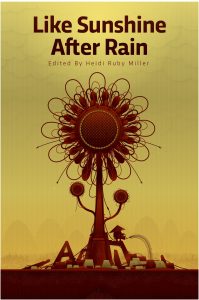 (HRM) At the height of the pandemic, I put together Like Sunshine After Rain, a charity anthology (published by RDSP) that featured 85 authors from seven different countries. The book was an attempt to raise money and awareness for the Leukemia and Lymphoma Society. It was the only way I knew how to cope with someone very close to me who had been diagnosed with Stage 4 blood cancer.
(HRM) At the height of the pandemic, I put together Like Sunshine After Rain, a charity anthology (published by RDSP) that featured 85 authors from seven different countries. The book was an attempt to raise money and awareness for the Leukemia and Lymphoma Society. It was the only way I knew how to cope with someone very close to me who had been diagnosed with Stage 4 blood cancer.
None of the authors got paid, artist Bradley Sharp donated a beautiful cover, my mum provided interior artwork, and RDSP didn’t accept a profit. The whole book was a labor of love. The outpouring of support showed me that I had built some meaningful relationships in an industry that can sometimes be cold and mercurial. John from RDSP even helped me put together a free two-day virtual launch event on their conferencing platform — AllAccessCon — where contributors read their stories. We also had tons of giveaways at the event, and the audience got to ask questions of their favorite authors. I will never forget the experience.
(SLW) What are you working on right now and what can we look forward to from you in the near future?
(HRM) Jason and I wrote like there would be no tomorrow during the pandemic, probably because it truly felt that way at times. We began collaborating on several works while coming up with plots during long hikes at nearby Ohiopyle State Park. We ended up writing four novels together in two different series, both of which our agent, Cherry Weiner, is currently shopping. The thriller series is set in a world which feels like Mission Impossible meets the X-Files and Men in Black during the 1980s. Our Hank Ruby middle grade series (written for our awesome nephew) takes place at Oakland Science Academy where The Mysterious Benedict Society meets a scientific version of The Magicians. We also plotted out one novel in a cozy mystery series that takes place in Big Sur, California, one of our favorite places. It features a character named Summer (think of all the puns for titles: Summer’s End, Last Days of Summer . . .)
(SLW) Is there anything else you’d like to mention?
(HRM) I would like to thank the pulp community for embracing me and my work. I attended my first PulpFest after writing a short story for Michael Croteau and Paul Spiteri — editors at Meteor House Press — for The Worlds of Philip José Farmer: Portraits of a Trickster anthology, and I immediately felt at home among the pulpsters. I still do.
(SLW) Thank you, Heidi, for the great conversation! As a woman author myself, I found your story very inspiring and look forward to hearing more from you in the future.
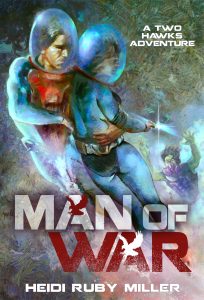
Want to learn more about Heidi Ruby Miller and her work? You’ll find her official website at heidirubymiller.com. While you’re there, you can subscribe to her Small Space Big Life newsletter. Pictured here is Heidi’s novel, Man of War. Published by Meteor House in 2017, it features cover art by Mark Wheatley. The other cover art featured in our post is by Bradley Sharp.
A professional journalist and illustrator with over thirty years of experience, Sara Light-Waller is an accomplished new-pulp fiction author/illustrator with two books out and more on the way. She is also the winner of the 2020 Cosmos Prize for her illustrated short story, “Battle at Neptune.” A huge pulp fan, Sara is especially fond of science fiction pulps. The extent of her pulp fandom can best be measured by the oversized rendition of Frank R. Paul’s AMAZING STORIES cover that she painted on her garage. Sara is a member of the PulpFest organizing committee and a regular contributor to our homepage and The Pulpster.


